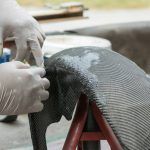Gift wrapping is an art form, but all those ribbons and bows end up getting thrown away shortly after they are admired.
Knowing what gift wrapping materials are eco-friendly can help you continue to present beautiful gifts without creating too much harmful waste.
Raffia is a common choice for ribbons not only for gift wrapping, but for arts and crafts, and much more.
You might be wondering whether or not you should look for raffia products and whether or not they are harmful to the planet.
Is Raffia Biodegradable?
Paper raffia ribbon and other products made of natural raffia are biodegradable.
This means they will break down over time when in a landfill.
That being said, there are two types of raffia and they are not created equal.
If the raffia is made from natural resources, it can biodegrade.
However, there is such a thing as synthetic raffia, which is not as sustainable or eco-friendly.
However, if you are able to find synthetic raffia crafted from wood pulp, it’s possible that it will be biodegradable depending on what other materials it is crafted with.
If the natural raffia you are using is dyed with natural dyes, or doesn’t contain any dyes, you are also able to throw it in your compost bin.
If you are not sure about the dyes used on your natural raffia, it’s best to throw it in the garbage if it cannot be reused.
Is Raffia Recyclable?
Natural raffia can be recycled and repurposed into other raffia products depending on its condition. Synthetic raffia may be a little bit more difficult to recycle.
If it contains a lot of synthetic dye or metallic dye, it will be harder to recycle.
What Is Raffia?
Raffia is made from palm tree leaves.
The leaves are cut in a very specific manner and are left to dry out in the sun. The sun dries out the leaves and makes them develop into brown strings.
Once this process is done, the raffia can be colored and crafted.
Synthetic raffia is made from nylon or polypropylene, which are both plastics.
The processing involved with manufacturing both of these plastics is harmful for the environment, and they do not biodegrade.
Depending on what the synthetic raffia is crafted into, it may or may not be able to be recycled.
What Is Raffia Used For?
Not only is raffia used to craft gift wrapping supplies and art products, but it can also be used for home decor and fashion.
It’s similar to straw, but is much more pliable, so it can be used to manufacture so many items in a much more sustainable way.
Some common items you might see crafted from raffia include footwear and sandals, handbags, baskets and storage items, as well as ropes and ribbon. It’s lightweight and breathable when worn.
Synthetic and natural raffia are both able to be dyed different colors, but synthetic raffia can withstand a little bit more, so it’s often made metallic or has patterns added to it.
Is Raffia A Reliable Material?
Regardless of what type of raffia you opt for, you will be using material that is very durable, but also flexible.
This means you’ll be able to mold it into whatever you wish, without having to worry about it breaking apart easily.
Are There Any Environmental Impacts That Make Raffia Unsustainable?
Natural raffia can potentially be sustainable.
Being that it is harvested from plants, it is renewable, since palm trees can be replanted.
Furthermore, the bark and stems from palm trees can also be used in other ways, so no part of the palm tree goes to waste.
However, the palm trees have to be harvested responsibly in order for the natural raffia that is subsequently made from the leaves to be truly sustainable.
In order to harvest the palm leaves responsibly, they should not be over harvested.
Many regions containing palm trees have laws in place to ensure this doesn’t happen.
Is Synthetic Raffia To Be Avoided?
The choice is ultimately yours when it comes to your preference for natural or synthetic raffia, but it’s important to know that synthetic raffia is not sustainable.
The manufacturing process can lead to harm towards the environment.
Furthermore, the materials used to manufacture synthetic raffia are not sustainable or environmentally friendly.
Some synthetic raffia can be recycled depending on how it is treated, which is good.
However, a lot of energy is used in recycling, and the more treated it is, the more energy is needed to turn the synthetic raffia into something that can be reused.
Natural raffia can serve the same purposes as synthetic raffia, so it would be preferable to go the natural route when possible.
Natural raffia is being used more and more to create new types of packaging, homewares, and clothing, as more people continue to seek out more sustainable items they can use in their everyday life.


